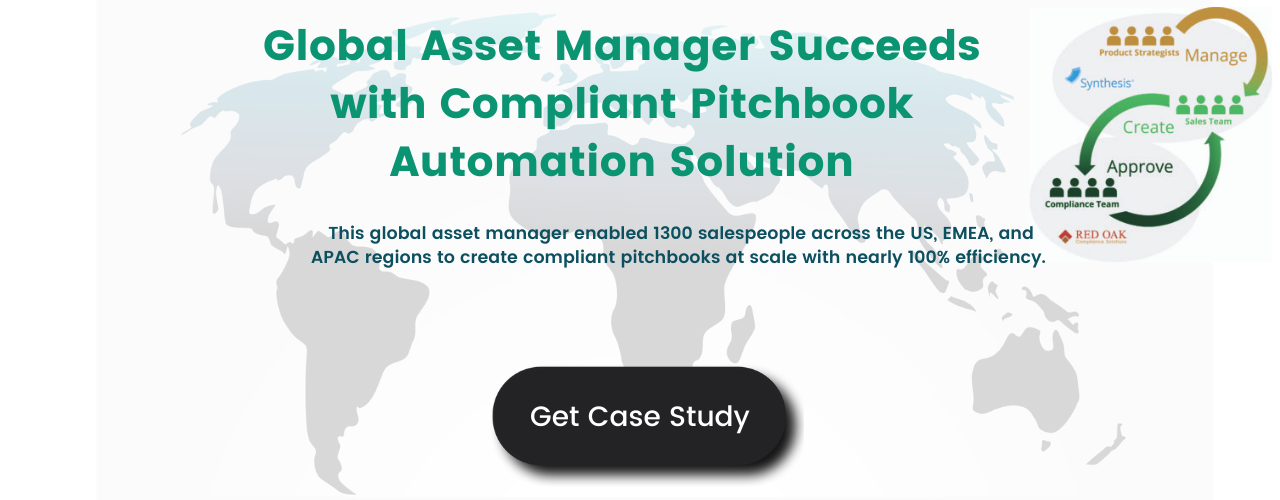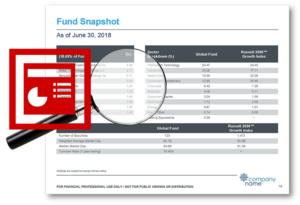Why Efficient Marketing Compliance Processes Help Avoid Hefty Fines & Needless Back and Forth

Guest Post by Amy Watson at Red Oak Compliance.
Asset Managers are heavily focused on bringing in new business and attracting the right clientele. Compliance, while important, is something you’d prefer to have running smoothly in the background rather than disrupting your day-to-day flow.
However, an increase in hefty fines throughout the asset management industry means compliance needs to be front-and-center. To make the most of your resources and to ensure you’re not caught by surprise when regulators review your materials, you need to ensure you’ve built efficient, compliant processes that are easy for your team to understand and comply with.
One particular pain point we’ve heard about from clients: keeping sales team collateral up to date and books and records compliant across an organization.
What’s new in the regulatory environment?
The importance of preventive measures has increased in recent years as the regulatory environment has become stricter and more penalty-oriented.
Regulators have started to zero in on risky sales practices and cultures after recent high-profile cases shed light on the sales pressures firms were placing on their representatives. In many cases, the sales requirements and incentives were so substantial they promoted unseemly behavior.
To reduce the possibility of this impact in the future, regulators are focusing on ensuring firms don’t over-promise in their material, leave risks unstated, or include inappropriate disclosures, among other factors.
An advertising review violation isn’t usually a seminal issue for a firm. It’s more often a symptom of something else that needs to be fixed within a firm’s compliance or promotional culture – where clients feel they’re being treated unfairly or where regulators might define certain practices as being aggressive/predatory.
If a firm is genuinely working to improve its policies and procedures, as well as focusing on the consumer’s right to accurate financial decision-making information, regulators may give them grace and the opportunity to make appropriate changes rather than imposing draconian penalties.
That’s where an effective, well-defined, process-oriented review process comes into play.
Related Case Study: Global Asset Manager Succeeds with Compliant Pitchbook Automation Solution
What are the problems with the current marketing review process?
Your firm is probably like many others in the asset management space, juggling multiple responsibilities, maintaining current clients and seeking opportunities for growth.
You know the headaches that can accompany the process of reviewing materials for your salespeople to use — and the difficulties that come with keeping track of information for your books and records.
Especially in the tumult of the past year, it can be easy to have a few items slide past you – missing presentations given by sales representatives or having expired or unapproved materials in your employees’ resource options.
Salespeople, looking to be responsive and make deals quickly, may be more likely to proceed with a presentation than to lose a lead because their compliance person didn’t get back to them in a timely manner. Employees managing a host of responsibilities are probably not focusing their attention on the small-print expiration dates on their materials.
Bad actors are rarely the cause of these types of infractions. Instead, the hasty bypassing of best practices is often a result of inefficient systems that are difficult to follow or take too long.
However, they can still result in fines and potential embarrassment to firms, even the ones with the best intentions to serve their customers well and fairly. That’s why having a compliance-driven presentation management process is so important.
What does the process look like for firms to prevent and detect problems to mitigate risk?
With or without technology, every firm has some sort of in-house process aimed at mitigating risk. A firm can break down risk mitigation into two categories: prevention and detection.
On the prevention side, firms should retrain salespeople to understand policies and procedures while ensuring they know the consequences to them and the business if guidelines aren’t followed.
On the detect side, audit teams should actively look for/review presentation material and ensure it has been approved for use.
If the firm discovers a presentation has been created with unapproved material, it may be necessary to provide additional education/support. Dedicate time to training salespeople on appropriate review processes and ensuring they have a good understanding of required processes.
To encourage compliance for both these processes, firms should make sure people understand how important it is to follow the policies and procedures.
Highlight how compliance can be a strategic advantage, how it correlates to continued success, to keeping the firm running smoothly, and to avoiding findings, fines or other negative issues that could impact its viability.
No one really wants to be disorganized or to create issues that get their company in hot water with regulators.
However, if the system (manual or tech-driven) is complex or time-consuming, they’ll work around the process if they’re running up against a deadline or if they don’t understand the value of their processes.
Many companies also worry about the heavy lift that comes with creating a robust program and invest extensive resources before getting anything moving.
Instead of trying to reach perfection with your initial plan, focus on complying with regulators, providing an adequate means to prevent and detect problems, then iterating on the process until you create a flow that truly works for your team.
Employing technology, including the integrated regulatory compliance solutions provided by companies like Synthesis or Red Oak, can make the iteration process much easier than dedicating resources to build a resource management program from scratch.
What considerations can you take to make this process the most effective as possible to implement?
Sales representatives are focused on meeting their goals and often don’t prioritize the back-end portion of the marketing compliance process. They need streamlined workflows that can be accessed quickly and efficiently.
For a firm to get sales representatives on board, a holistic solution — like the integrated systems from Synthesis and Red Oak Compliance — can make it easier and faster to get custom material approved.
How does this process streamline the experience for representatives? Typically, a marketing team will first create and submit templates for approval, then publish the approved templates for use.
Then, various representatives can come in and use these templates. The system will guide them through making “non-material changes” to their presentations. Finally, the system notifies representatives when their materials have been approved for use.
This process drastically reduces instances where sales representatives use unapproved versions of presentations when the approval process takes too long. Additionally, because there is a category of standardized and pre-approved literature, the representative does not have to spend additional time waiting for custom materials to be created.
What issues or objections should you expect to encounter from your sales team and how should you best handle it?
Territorialism can often be an issue when you’re asking a team to hand over control and to trust a process to a centralized authority.
To make this transition, you need to focus on building trust and emphasizing the value and time-saving that goes along with a centralized process. Sell them on the switchover by making it as organized as possible and by emphasizing that the process will both satisfy regulatory/compliance concerns and reduce delays for salespeople.
You can further reduce resistance by delineating workflows based on risk and breaking them down into high, medium and low-risk levels.
The steps and complexity of workflows can be greatly reduced when most of the material is being post-use audited. Synthesis’ tool, for example, can create a low-risk workflow with a purpose of ensuring nobody’s gone rogue and somehow broken the system.
When this workflow is in place, sales representatives can get immediate approval of their materials (generally for producing presentations with minor changes like incorporating personal details, client details or content information).
Separating these low-risk items from other presentations means fewer impediments to medium-risk work as well. When low-risk items are cleared from the system, the compliance team will have additional bandwidth freed up to review and approve material more expeditiously.
These elements – along with Synthesis/Red Oak technology and proper rep training – work in tandem to get material in use as quickly as possible. And it reduces work and strain for both audit prep and for examiners. Documents are books and records compliant 100% of the time and branch examiners can easily cross-reference materials and ensure approval.
What benefits can make a compliance management process more attractive to hesitant sales teams?
The key benefits of implementing a compliance-driven presentation management process include improved flexibility, effectiveness and strategic/competitive advantages. With a set process and compliance workflow in place:
- There is less back and forth on the customized use of pre-approved templates. In a normal workday or week, teams get busy, and the review process’s effectiveness is reduced because of the fear of holding up sales. Compliance professionals may feel pressured to rubber-stamp material and say it’s good enough, which can be harmful from a regulatory perspective.
- Firms can consider risk reduction as a revenue opportunity. Saved money by avoiding fines means less work for sales teams to bring in additional revenue in order to offset those expenses.
- Regulators continue to levy more significant fines for findings/infractions. By putting the appropriate workflows in place now, you’ll save time and resources over scrambling to change your operating procedures when your firm is under the wire from an examiner.
When you’re building marketing compliance processes, others in your firm may think you’re giving them additional work to streamline things for yourself.
It’s your responsibility to ensure they’re seeing the value created by these processes – that an efficient presentation/resource management system will streamline their workflow, support their client outreach goals and keep the firm protected from fines that could impact overall success and longevity.
Learn how one global asset manager uses Synthesis and Red Oak Compliance to achieve a seamless and compliant pitchbook creation workflow.
Here are some related resources that might interest you:







 Compare the Top 3 Finserv Content Automation Vendors [White paper]
Compare the Top 3 Finserv Content Automation Vendors [White paper] Create Pitchbooks the Drive Sales [White paper]
Create Pitchbooks the Drive Sales [White paper] Build vs. Buy: Should Your Financial Services Firm Outsource or Insource Marketing Technology? [White paper]
Build vs. Buy: Should Your Financial Services Firm Outsource or Insource Marketing Technology? [White paper]  10 Tips for Rebranding your Fund Marketing Documents [White paper]
10 Tips for Rebranding your Fund Marketing Documents [White paper]

